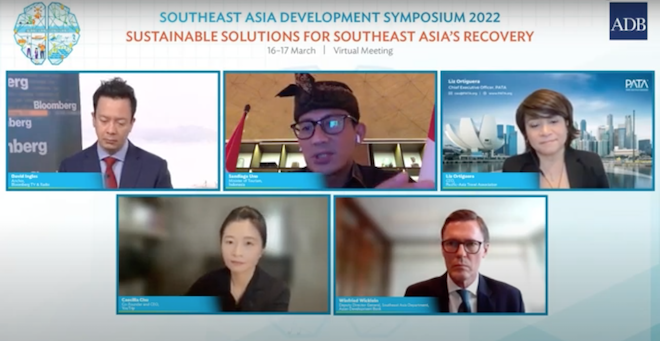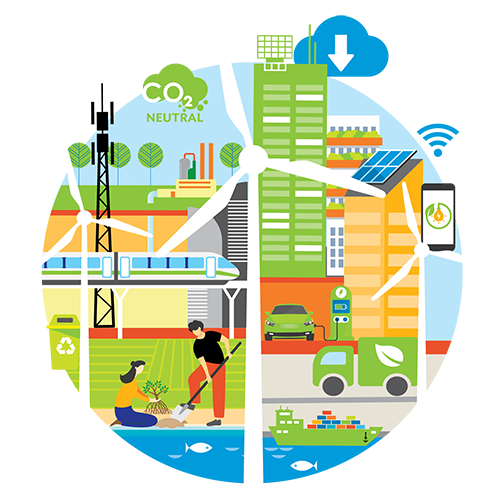
Sandiaga Salahuddin Uno wished hotels would stop offering buffets to tourists. Indonesia’s Minister of Tourism and Creative Economy, who used to run hotels, felt buffets are a waste especially at a time when tourism businesses needed to bring down costs as they try to revive their operations in the wake of the coronavirus disease (COVID-19) pandemic.
“Come on, guys. Buffet in this era? People don't go for buffets,” Uno said during the recently held Southeast Asia Development Symposium (SEADS) organized by the Asian Development Bank (ADB). He said tourists no longer go for buffets, preferring to eat by themselves or consume a limited amount of food. In the end, the food just goes to waste, he said.
Uno made the statement during the panel discussion, “Driving an Inclusive Tourism Recovery in Southeast Asia,” where he and the other speakers agreed that shifting to sustainable tourism is key to reviving the region’s travel sector.
Tourist arrivals to the region plunged 82% in 2020 as travel ground to a halt after countries imposed lockdowns and border closures to stop the spread of the virus.
As Southeast Asia starts reviving travel, there is a growing consensus the pandemic is an opportunity to fix structural issues that have plagued tourism over the years and rebuild it greener.
Across the region, there are numerous examples of rapid tourism growth harming the environment. For instance, Boracay island in the Philippines saw tourist arrivals increase 160% between 2011 and 2017 but sewer and waste management systems were unable to keep up. As a result, in 2018, Boracay was temporarily closed to visitors for about 6 months for environmental rehabilitation.
Shift toward more conscientious travel
ADB Southeast Asia Department Deputy Director General Winfried Wicklein, one of the panelists, said reviving tourism is vital to Southeast Asia’s recovery as before the pandemic, it contributed about 12% to the region’s gross domestic product and employed more than 40 million workers, majority of whom are women working for small and medium-sized enterprises supplying goods or services to the sector.
“I think COVID-19 in some ways will be an opportunity also, as bad as it has been, to recover and to build back better in an environmentally sustainable fashion so we can address some of the structural issues that we've always wanted to address and just basically start from new—the right way,” he said.
The United Nations World Tourism Organization (UNWTO) defines sustainable travel as “tourism that takes full account of its current and future economic, social, and environmental impacts, addressing the needs of visitors, the industry, the environment, and host communities.”
Indonesia is already making the shift, with Uno’s plea to the hotel and accommodation operators just one of the moves Southeast Asia’s most populous country has made.
Indonesia is also moving away from mass tourism in favor of ecotourism and sports tourism and is bent on promoting nature and culture to tourists. “We're moving away from quantity. We're focusing on quality and sustainability,” the minister said.
As part of the shift, Indonesia is pushing community-based tourism to empower 3,000 villages across the country. Through this project, target villages can offer creative economy products to tourists like local food and traditional keepsakes like headgears. “This is a new way of quality tourism whereby it impacts the local communities,” he said.
He said travelers spending their holiday in Indonesia can offset the carbon footprint from their flights through activities like mangrove planting and waste management, and by empowering local communities who benefit from their tourist dollars.
Indonesia is also targeting longer-staying tourists, he said, referring to “digital nomads”—remote workers who stay a month or longer in destinations to combine work with leisure.
Having longer-staying tourists is better for the local economy because they tend to spend more on locally produced goods and services, which has positive economic knock-on effects. It is better for the environment as increasing the availability and consumption of local products by fewer but longer-staying visitors can shorten supply chains and reduce negative environmental externalities—two critical factors for building destination resilience and sustainability.
Liz Ortiguera, CEO of the Pacific Asia Travel Association (PATA), predicts the industry will move toward longer-stay designed properties to cater to these travelers. “That's what the consumer wants—they want the ‘workation.’ They want to have multiple purposes when they travel to make it more efficient.”
It will be up to governments on how they can create the right environment that would support the sustainable form of travel that would bring funds back into the community and support small businesses to be more sustainable for the local culture and the local economy
Asked whether governments should forego taxing accommodation providers to allow the industry to recover first, Wicklein replied, “I don't think the government should step aside totally because we have an opportunity now to rebuild better.”
He noted the need to sit down with governments and help them strengthen the regulatory framework that will address policy gaps relating to taxing online businesses catering to tourists.

Rise of the intelligent traveler
Stakeholders should also prepare to attract a new type of tourists—the intelligent luxury traveler, said Ortiguera. This “modern responsible traveler” looks more deeply, she said. “It's not just doing an Instagram tour to take a photo in a much traveled location just to get a very superficial introduction. It's intelligent luxury and that means wellness for yourself, for the community, and also for the environment. So it's like a holistic wellness. It's a much more inclusive and sustainable offering, both for the host country as well as the traveler.”
As countries revive tourism, they need to develop the market to cater to these travelers. Travelers should also seek destinations offering these types of services and products when they return to the region, she said.
Countries also need to think about reviewing metrics for sustainable travel and making sure tourist dollars that come in actually benefit the community and the local economy. “Having the right metrics will also help us as leaders steer in the right direction in terms of what to encourage. It won't just be about heavy traffic and we don't want that actually. We want dispersion. We want longer stays. And new forms of travel will emerge.”
Technology’s role
Technology also has a role to play as countries try to nurse tourism back to health.
Caecilia Chu, cofounder and CEO of digital travel wallet YouTrip, said small businesses in the tourism industry should tap digital tools to unlock opportunities for growth. For instance, they could put up a digital storefront or advertise on global online platforms to widen their reach, she said.
Adopting digital payment systems can also help them, as it can reduce the time and cost spent on transactions. “By digitalizing more of the businesses in the region, I think it would certainly help reduce the transaction cost and time and really help everyone do a bit more business.”
Ortiguera said technology can also play a critical role in upskilling and reskilling the industry’s frontline and lower-income workers, particularly on issues like health and safety and learning about online marketing.
Uno has observed that in Indonesia, tourism businesses which have not embraced technology struggle to fill in occupancy.
Green financing
Greening tourism though will have a cost, said Wicklein, noting countries would need to attract investments and use innovative financing approaches at a time when state coffers are already strained as countries press with their post-pandemic recovery efforts.
He cited ADB’s newly launched Southeast Asia Sustainable Tourism Hub among resources countries may tap. He said the hub can help develop and finance innovative tourism projects, promote public–private partnership tourism projects, build tourism destination management capacity, and support some of the technologies that can bolster the industry.
He noted that one of the issues in development finance in the region has been the lack of bankable projects. The facility can thus help member countries develop and structure projects that are bankable for the private sector and help governments develop and design suitable projects. It can also help provide access to some of the green finance mechanisms and facilities ADB has set up.
Wicklein is optimistic about what these green tourism projects would mean for Southeast Asia's labor market. “Green means jobs,” he said.

